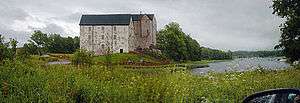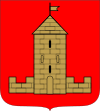Sund, Åland
| Sund | ||
|---|---|---|
| Municipality | ||
| Sunds kommun | ||
|
Kastelholm Castle in 2004 | ||
| ||
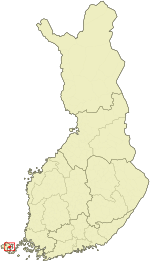 Location of Sund in Finland | ||
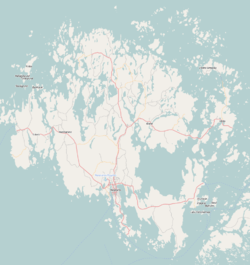 Sund Location in Åland | ||
| Coordinates: 60°15′N 020°07′E / 60.250°N 20.117°ECoordinates: 60°15′N 020°07′E / 60.250°N 20.117°E | ||
| Country | Finland | |
| Region | Åland | |
| Sub-region | Countryside sub-region | |
| Government | ||
| • Municipal manager | Christina Nukala-Pengel | |
| Area (2011-01-01)[1] | ||
| • Total | 184.12 km2 (71.09 sq mi) | |
| • Land | 108.06 km2 (41.72 sq mi) | |
| • Water | 76.06 km2 (29.37 sq mi) | |
| Area rank | 310th largest in Finland | |
| Population (2016-03-31)[2] | ||
| • Total | 1,033 | |
| • Rank | 321st largest in Finland | |
| • Density | 9.56/km2 (24.8/sq mi) | |
| Population by native language[3] | ||
| • Swedish | 94.2% (official) | |
| • Finnish | 3.5% | |
| • Others | 2.3% | |
| Population by age[4] | ||
| • 0 to 14 | 17.8% | |
| • 15 to 64 | 63.1% | |
| • 65 or older | 19% | |
| Time zone | EET (UTC+2) | |
| • Summer (DST) | EEST (UTC+3) | |
| Municipal tax rate[5] | 18.5% | |
| Website | www.sund.ax | |
Sund is a municipality of Åland. It is an autonomous territory of Finland which is very rich in history and culture, being one of the official 27 National landscapes of Finland.
The municipality has a population of 1,033 (31 March 2016)[2] and covers an area of 184.12 square kilometres (71.09 sq mi) of which 76.06 km2 (29.37 sq mi) is water.[1] The population density is 9.56 inhabitants per square kilometre (24.8/sq mi).
The municipality is unilingually Swedish.
The old Medieval post route from Stockholm, Sweden to Turku, Finland passes through Sund.
History and landmarks
There are many pre-historic sites in Sund from the Stone, Bronze and Iron Ages.
The Medieval church of Sund is dedicated to John the Baptist and was built sometime in the 13th century. It is the largest church in Åland. Inside the church there is a five-meter-tall crucifix, the tallest in all of Scandinavia.
Kastelholm Castle (Swedish: Kastelholms slott) is the only castle in Åland, and is partially in ruins. The castle was built on a small island that was surrounded by water and moats filled with several lines of poles. It was first mentioned in 1388 in the contract of Queen Margaret I, where a large portion of the inheritance of Bo Jonsson Grip was given to her. The heyday of the castle was in the 15th and 16th centuries. King John III kept his deposed brother Eric XIV in captivity in the castle in the Fall of 1571. Today, it is partially restored and a popular tourist attraction. The whole castle was opened to the public in 2001.
The Bomarsund Fortress (Swedish: Bomarsunds fästning) is one of the most interesting historical places in Sund. After Sweden had lost the Finnish War of 1808–09, fought against Russia, both Åland and Finland became part of the Russian Empire. Russia began to build a fortress in Sund in 1830 in accordance with the orders of Emperor Nicholas I. People of various cultural backgrounds came to Sund from all over Russia to build the fortress. A town, Gamla Skarpans, was built and another settlement, Nya Skarpans, was established inside the fortress. However, the fortress, designed for 5000 men and 500 cannons, was never finished because in 1854 during the Crimean War English and French troops invaded and blew it up. Today, in addition to the fortress, there are the ruins of Gamla Skarpans and two watchtowers nearby, all open to visitors.
The Outdoor Museum Jan Karlsgården (Swedish: Jan Karlsgården friluftsmuseum) is next to Kastelholm Castle. There are old buildings from all over Åland, such as windmills, a steam sauna and a blacksmith's shop.
The Prison Museum Vita Björn (Swedish: Fängelsemuseet Kronohäktet Vita Björn) is also near the Kastelholm Castle. It was originally built in 1784 to serve as a prison and operated until as recently as 1975. Today it is a museum.
Economy
Tourism is one of the biggest lines of business in Sund. Agriculture is also popular, especially keeping livestock. Small businesses are also abundant and the biggest employers are the municipality and the local golf course.
Image gallery
 A building at the Outdoor Museum Jan Karlsgården
A building at the Outdoor Museum Jan Karlsgården A part of the wall of the Bomarsund Fortress
A part of the wall of the Bomarsund Fortress.png) Kastelholm Castle in the late 17th century
Kastelholm Castle in the late 17th century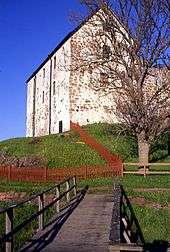 Kastelholm Castle
Kastelholm Castle Kastelholm Castle
Kastelholm Castle Bridge to Prästö in Sund municipality
Bridge to Prästö in Sund municipality View from the bridge between Sund and Finström
View from the bridge between Sund and Finström- Sund in April 2012
 Church of Sund parish
Church of Sund parish- Bomarsund, Åland
 A computer model of Bomarsund fortress
A computer model of Bomarsund fortress- Canon in Bomarsund fortress
References
- 1 2 "Area by municipality as of 1 January 2011" (PDF) (in Finnish and Swedish). Land Survey of Finland. Retrieved 9 March 2011.
- 1 2 "Ennakkoväkiluku sukupuolen mukaan alueittain, maaliskuu.2016" (in Finnish). Statistics Finland. Retrieved 31 March 2016.
- ↑ "Population according to language and the number of foreigners and land area km2 by area as of 31 December 2008". Statistics Finland's PX-Web databases. Statistics Finland. Retrieved 29 March 2009.
- ↑ "Population according to age and gender by area as of 31 December 2008". Statistics Finland's PX-Web databases. Statistics Finland. Retrieved 28 April 2009.
- ↑ "List of municipal and parish tax rates in 2011". Tax Administration of Finland. 29 November 2010. Retrieved 13 March 2011.
External links
![]() Media related to Sund, Åland at Wikimedia Commons
Media related to Sund, Åland at Wikimedia Commons
- Municipality of Sund – Official website
- Map of Sund municipality
